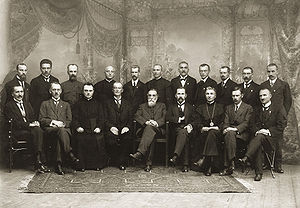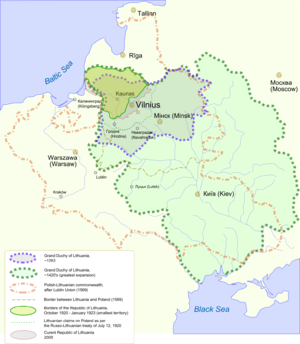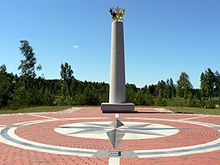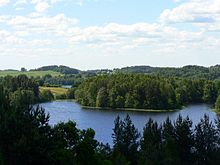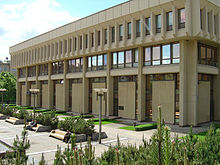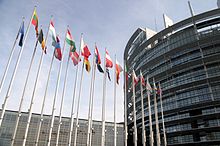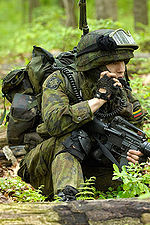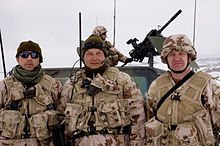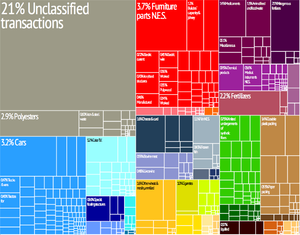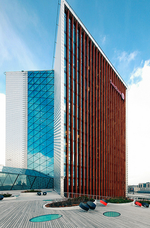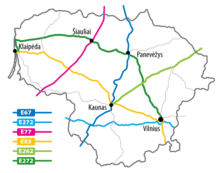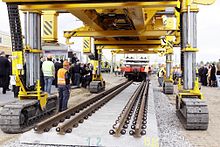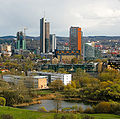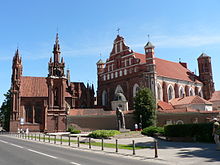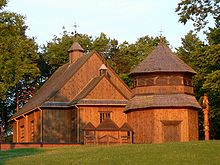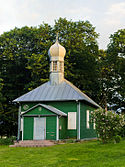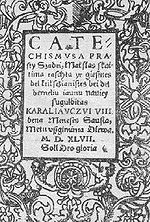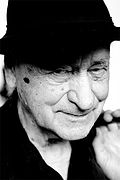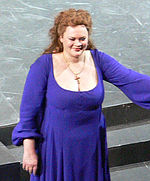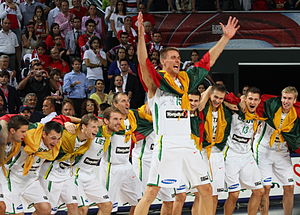
Lithuania
Background Information
This Wikipedia selection is available offline from SOS Children for distribution in the developing world. Sponsor a child to make a real difference.
| Republic of Lithuania Lietuvos Respublika
|
||||||
|---|---|---|---|---|---|---|
|
||||||
| Anthem: Tautiška giesmė National Hymn |
||||||
|
Location of Lithuania (dark green)
– in Europe (green & dark grey) |
||||||
| Capital and largest city |
Vilnius 54°41′N 25°19′E |
|||||
| Official languages | Lithuanian | |||||
| Ethnic groups (2011) |
|
|||||
| Demonym | Lithuanian | |||||
| Government | Parliamentary republic | |||||
| - | President | Dalia Grybauskaitė | ||||
| - | Prime Minister | Algirdas Butkevičius | ||||
| - | Seimas Speaker | Vydas Gedvilas | ||||
| Legislature | Seimas | |||||
| Independence from Russia / Germany (1918) | ||||||
| - | First mention of Lithuania | 9 March 1009 | ||||
| - | Coronation of Mindaugas | 6 July 1253 | ||||
| - | Union with Poland | 2 February 1386 | ||||
| - | Polish–Lithuanian Commonwealth created |
1 July 1569 | ||||
| - | Partitions of the Commonwealth | 24 October 1795 | ||||
| - | Independence declared | 16 February 1918 | ||||
| - | 1st Soviet occupation | 15 June 1940 | ||||
| - | Nazi German occupation | 22 June 1941 | ||||
| - | 2nd Soviet occupation | July 1944 | ||||
| - | Independence restored | 11 March 1990 | ||||
| Area | ||||||
| - | Total | 65,300 km2 ( 123rd) 25,212 sq mi |
||||
| - | Water (%) | 1.35 | ||||
| Population | ||||||
| - | 2013 estimate | 2,972,949 ( 133rd) | ||||
| - | 2011 census | 3,043,429 | ||||
| - | Density | 50.3/km2 ( 120th) 141.2/sq mi |
||||
| GDP ( PPP) | 2012 estimate | |||||
| - | Total | $64.318 billion | ||||
| - | Per capita | $20,088 | ||||
| GDP (nominal) | 2012 estimate | |||||
| - | Total | $42.438 billion | ||||
| - | Per capita | $13,068 | ||||
| Gini (2008) | 37.6 medium |
|||||
| HDI (2013) | very high · 41st |
|||||
| Currency | Lithuanian litas (Lt) ( LTL) |
|||||
| Time zone | EET ( UTC+2) | |||||
| - | Summer ( DST) | EEST ( UTC+3) | ||||
| Date format | yyyy-mm-dd ( CE) | |||||
| Drives on the | right | |||||
| Calling code | +370 | |||||
| ISO 3166 code | LT | |||||
| Internet TLD | .lta | |||||
| a. | Also .eu, shared with other European Union member states. | |||||
Lithuania ( / ˌ l ɪ θ uː ˈ eɪ n i ə / or / ˌ l ɪ θj uː ˈ eɪ n i ə /; Lithuanian: Lietuva), officially the Republic of Lithuania ( Lithuanian: Lietuvos Respublika) is a country in Northern Europe, the largest of the three Baltic states. It is situated along the southeastern shore of the Baltic Sea, to the east of Sweden and Denmark. It borders Latvia to the north, Belarus to the east and south, Poland to the south, and Kaliningrad Oblast (a Russian exclave) to the southwest. Lithuania has an estimated population of 3 million as of 2012, and its capital and largest city is Vilnius. The Lithuanians are a Baltic people, and the official language, Lithuanian, is one of only two living languages (together with Latvian) in the Baltic branch of the Indo-European language family.
For centuries, the southeastern shore of the Baltic Sea was inhabited by various Baltic tribes. In the 1230s the Lithuanian lands were united by Mindaugas, who was crowned as King of the Lithuania, creating the first unified Lithuanian state, on 6 July 1253. During the 14th century, the Grand Duchy of Lithuania was the largest country in Europe: present-day Belarus, Ukraine, and parts of Poland and Russia were territories of the Grand Duchy of Lithuania. With the Lublin Union of 1569, Lithuania and Poland formed a voluntary two-state union, the Polish–Lithuanian Commonwealth. The Commonwealth lasted more than two centuries, until neighboring countries systematically dismantled it from 1772 to 1795, with the Russian Empire annexing most of Lithuania's territory.
In the aftermath of World War I, Lithuania's Act of Independence was signed on 16 February 1918, declaring the re-establishment of a sovereign state. Starting in 1940, Lithuania was occupied first by the Soviet Union and then by Nazi Germany. As World War II neared its end in 1944 and the Germans retreated, the Soviet Union reoccupied Lithuania. On 11 March 1990, the year before the break-up of the Soviet Union, Lithuania became the first Soviet republic to declare independence.
Prior to the global financial crisis of 2007–2010 and now in its aftermath, Lithuania has one of the fastest growing economies in the European Union. Lithuania is a member of NATO, the Council of Europe, and the European Union. Lithuania is also a full member of the Schengen Agreement. The United Nations Human Development Index lists Lithuania as a "Very High Human Development" country. Lithuania will hold the Presidency of the Council of the European Union in the second half of 2013.
History
Prehistoric
The first people settled in the territory of Lithuania after the last glacial period in the 10th millennium BC. Over a millennium, the Proto-Indo-Europeans, who arrived in the 3rd – 2nd millennium BC, mixed with the local population and formed various Baltic tribes. The first written mention of Lithuania is found in a medieval German manuscript, the Annals of Quedlinburg, in an entry dated 9 March 1009.
Medieval
Initially inhabited by fragmented Baltic tribes, in the 1230s the Lithuanian lands were united by Mindaugas, who was crowned as King of Lithuania on 6 July 1253. After his assassination in 1263, pagan Lithuania was a target of the Christian crusades of the Teutonic Knights and the Livonian Order. Despite the devastating century-long struggle with the Orders, the Grand Duchy of Lithuania expanded rapidly, overtaking former Slavic principalities of Kievan Rus'.
By the end of the 14th century, Lithuania was one of the largest countries in Europe and included present-day Belarus, Ukraine, and parts of Poland and Russia. The geopolitical situation between the west and the east determined the multicultural and multi-confessional character of the Grand Duchy of Lithuania. The ruling elite practiced religious tolerance and borrowed Chancery Slavonic language as an auxiliary language to the Latin for official documents.
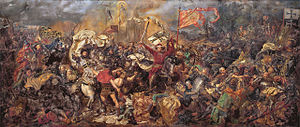
In 1385, the Grand Duke Jogaila accepted Poland's offer to become its king. Jogaila embarked on gradual christianization of Lithuania and established a personal union between Poland and Lithuania. It implied that Lithuania, the fiercely independent land, was one of the last pagan areas of Europe to adopt Christianity.
After two civil wars, Vytautas the Great became the Grand Duke of Lithuania in 1392. During his reign, Lithuania reached the peak of its territorial expansion, centralization of the state began, and the Lithuanian nobility became increasingly prominent in state politics. Thanks to close cooperation, the armies of Lithuania and Poland achieved a great victory over the Teutonic Knights in 1410 at the Battle of Grunwald, one of the largest battles of medieval Europe.
After the deaths of Jogaila and Vytautas, the Lithuanian nobility attempted to break the union between Poland and Lithuania, independently selecting Grand Dukes from the Jagiellon dynasty. But, at the end of the 15th century, Lithuania was forced to seek a closer alliance with Poland when the growing power of the Grand Duchy of Moscow threatened Lithuania's Russian principalities and sparked the Muscovite–Lithuanian Wars and the Livonian War.
Modern
The Polish–Lithuanian Commonwealth was created in 1569. As a member of the Commonwealth, Lithuania retained its institutions, including a separate army, currency, and statutory laws. Eventually Polonization affected all aspects of Lithuanian life: politics, language, culture, and national identity. From the mid-16th to the mid-17th centuries, culture, arts, and education flourished, fueled by the Renaissance and the Protestant Reformation. From 1573, the Kings of Poland and Grand Dukes of Lithuania were elected by the nobility, who were granted ever increasing Golden Liberties. These liberties, especially the liberum veto, led to anarchy and the eventual dissolution of the state.
During the Northern Wars (1655–1661), the Lithuanian territory and economy were devastated by the Swedish army. Before it could fully recover, Lithuania was ravaged during the Great Northern War (1700–1721). The war, a plague, and a famine caused the deaths of approximately 40% of the country's population. Foreign powers, especially Russia, became dominant in the domestic politics of the Commonwealth. Numerous factions among the nobility used the Golden Liberties to prevent any reforms. Eventually, the Commonwealth was partitioned in 1772, 1792, and 1795 by the Russian Empire, Prussia, and Habsburg Austria.
The largest area of Lithuanian territory became part of Russian Empire. After unsuccessful uprisings in 1831 and 1863, the Tsarist authorities implemented a number of Russification policies. They banned the Lithuanian press, closed cultural and educational institutions, and made Lithuania part of a new administrative region called Northwestern Krai. The Russification failed owing to extensive network of book smugglers and secret Lithuanian home schooling.
After the Russo-Turkish War (1877–1878), when German diplomats assigned what were seen as Russian spoils of war to Turkey, the relationship between Russia and the German Empire became complicated. The Russian Empire resumed the construction of fortresses at its western borders for defence against a potential invasion from Germany in the West. On 7 July 1879 the Russian Emperor Alexander II approved of a proposal from the Russian military leadership to build the largest "first-class" defensive structure in the entire state – the 65 km2 (25 sq mi) Kaunas Fortress. Between 1868 and 1914, approximately 635,000 people, almost 20% of the population, emigrated from Lithuania. Large numbers of Lithuanians went to the United States in 1867–1868 after a famine. A Lithuanian National Revival laid the foundations of the modern Lithuanian nation and independent Lithuania.
20th and 21st centuries
During World War I, the Council of Lithuania (Lietuvos Taryba) declared the independence of Lithuania on 16 February 1918, and the re-establishment of the Lithuanian State. Lithuania's foreign policy was dominated by territorial disputes with Poland and Germany. The Vilnius Region, and Vilnius, the historical capital of Lithuania, (and so designated in the Constitution of Lithuania) were seized by the Polish army during Żeligowski's Mutiny in October 1920 and annexed two years later by Poland. For 19 years Kaunas became the Temporary capital of Lithuania. The Polish occupation of Vilnius was greatly resented by Lithuania; there were no diplomatic relations between the two states for most of the period between the two world wars.
Acquired during the Klaipėda Revolt of 1923, the Klaipėda Region was ceded to Germany after a German ultimatum in March 1939. During the interwar period, the domestic affairs of Lithuania were controlled by the authoritarian President, Antanas Smetona and his party, the Lithuanian Nationalist Union, who came to power after the coup d'état of 1926.
The Soviet Union returned Vilnius to Lithuania after the Soviet invasion of Eastern Poland in September 1939. In June 1940, the Soviet Union occupied and annexed Lithuania in accordance to the secret protocols of Molotov–Ribbentrop Pact. A year later the Soviet Union was attacked by Nazi Germany, leading to the Nazi occupation of Lithuania. The Nazis and their collaborators murdered around 190,000 Jews of Lithuania (91% of the pre-war Jewish community) during the Holocaust.
After the retreat of the German armed forces, the Soviets re-established the annexation of Lithuania in 1944. Under border changes promulgated at the Potsdam Conference in 1945, the former German Memelland, with its Baltic port Memel (Lithuanian: Klaipėda), was again transferred to Lithuania, or as it was after 1945 the Lithuanian SSR. Most German residents of the area had fled in the final months of World War II.
The Soviets engaged in massive deportations of Lithuanians to Siberia, complete nationalisation and collectivisation and general sovietization of everyday life. From 1944 to 1952 approximately 100,000 Lithuanian partisans fought a guerrilla war against the Soviet system. An estimated 30,000 partisans and their supporters were killed, and many more were arrested and deported to Siberian gulags. It is estimated that Lithuania lost 780,000 people during World War II.
The advent of perestroika and glasnost in the late 1980s allowed the establishment of Sąjūdis, an anti-communist independence movement. After a landslide victory in elections to the Supreme Soviet, members of Sąjūdis proclaimed Lithuania's independence on 11 March 1990, becoming the first Soviet republic to do so. The Soviet Union attempted to suppress the secession by imposing an economic blockade. Soviet troops attacked the Vilnius TV Tower, killing 14 Lithuanian civilians and wounding 600 others on the night of 13 January 1991 ( January Events). On 31 July 1991 Soviet paramilitaries killed seven Lithuanian border guards on the Belarusian border in what became known as the Medininkai Massacre.
On 4 February 1991, Iceland became the first country to recognise Lithuanian independence. After the Soviet August Coup, independent Lithuania received wide official recognition and joined the United Nations on 17 September 1991. The last Soviet troops left Lithuania on 31 August 1993 – even earlier than they departed from East Germany. Lithuania, seeking closer ties with the West, applied for NATO membership in 1994. After a transition from a planned economy to a free market one, Lithuania became a full member of NATO and the European Union in the spring of 2004 and a member of the Schengen Agreement on 21 December 2007.
Geography
Lithuania is located in Northern Europe. It covers an area of 65,200 km2. Thus, in terms of total area, Lithuania is larger than the Netherlands, Belgium, Denmark or Switzerland.
Lithuania lies between latitudes 53° and 57° N, and mostly between longitudes 21° and 27° E (part of the Curonian Spit lies west of 21°). It has around 99 kilometres (61.5 mi) of sandy coastline, of which only about 38 kilometres (24 mi) face the open Baltic Sea and which is the shortest among the Baltic Sea countries; the rest of the coast is sheltered by the Curonian sand peninsula. Lithuania's major warm-water port, Klaipėda, lies at the narrow mouth of the Curonian Lagoon (Lithuanian: Kuršių marios), a shallow lagoon extending south to Kaliningrad. The main and largest river, the Nemunas River, and some of its tributaries carry international shipping.
Lithuania lies at the edge of North European Plain. Its landscape has been smoothed by the glaciers of the last ice age. Lithuania's terrain is an alternation of moderate lowlands and highlands; its maximum elevation is Aukštojas Hill at 294 metres (965 ft) in the eastern part of the country. The terrain features numerous lakes, Lake Vištytis for example, and wetlands; a mixed forest zone covers nearly 33% of the country. The climate ranges between maritime and continental, with wet, moderate winters and mildly hot summers.
After a re-estimation of the boundaries of the continent of Europe in 1989, Jean-George Affholder, a scientist at the Institut Géographique National (French National Geographic Institute) determined that the Geographic Centre of Europe is located at 54°54′N 25°19′E. The method used for calculating this point was that of the centre of gravity of the geometrical figure of Europe. This point is located in Lithuania, specifically 26 kilometres (16 mi) north of its capital city, Vilnius.
Climate
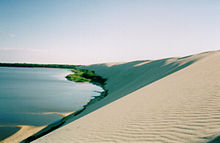
Lithuania's climate, which ranges between maritime and continental, is relatively mild. Average temperatures on the coast are −2.5 °C in January and 16 °C (61 °F) in July. In Vilnius the average temperatures are −6 °C (21 °F) in January and 16 °C (61 °F) in July. During the summer, 20 °C (68 °F) is common during the day while 14 °C (57 °F) is common at night; in the past, temperatures have reached as high as 30 °C (86 °F) or 35 °C (95 °F). Some winters can be very cold. −20 °C (−4 °F) occurs almost every winter. Winter extremes are −34 °C (−29 °F) in coastal areas and −43 °C (−45 °F) in the east of Lithuania.
The average annual precipitation is 800 mm on the coast, 900 mm in the Samogitia highlands and 600 mm in the eastern part of the country. Snow occurs every year, it can snow from October to April. In some years sleet can fall in September or May. The growing season lasts 202 days in the western part of the country and 169 days in the eastern part. Severe storms are rare in the eastern part of Lithuania but common in the coastal areas.
The longest measured temperature records from the Baltic area cover about 250 years. The data show that there were warm periods during the latter half of the 18th century, and that the 19th century was a relatively cool period. An early 20th century warming culminated in the 1930s, followed by a smaller cooling that lasted until the 1960s. A warming trend has persisted since then.
Lithuania experienced a drought in 2002, causing forest and peat bog fires. The country suffered along with the rest of Northwestern Europe during a heat wave in the summer of 2006.
| Month | Jan | Feb | Mar | Apr | May | Jun | Jul | Aug | Sep | Oct | Nov | Dec | Year |
|---|---|---|---|---|---|---|---|---|---|---|---|---|---|
| Record high °C (°F) | 12.6 (54.7) |
16.5 (61.7) |
21.8 (71.2) |
28.8 (83.8) |
34.0 (93.2) |
35.0 (95) |
37.5 (99.5) |
36.0 (96.8) |
32.0 (89.6) |
26.0 (78.8) |
18.5 (65.3) |
15.6 (60.1) |
37.5 (99.5) |
| Average high °C (°F) | −1.7 (28.9) |
−1.3 (29.7) |
2.3 (36.1) |
9.4 (48.9) |
16.5 (61.7) |
19.9 (67.8) |
20.9 (69.6) |
20.6 (69.1) |
15.8 (60.4) |
9.9 (49.8) |
3.5 (38.3) |
−0.1 (31.8) |
9.5 (49.1) |
| Daily mean °C (°F) | −3.9 (25) |
−3.5 (25.7) |
−0.1 (31.8) |
5.5 (41.9) |
11.6 (52.9) |
15.2 (59.4) |
16.7 (62.1) |
16.1 (61) |
12.2 (54) |
7.0 (44.6) |
1.8 (35.2) |
−1.7 (28.9) |
6.2 (43.2) |
| Average low °C (°F) | −6.3 (20.7) |
−6.6 (20.1) |
−2.8 (27) |
1.5 (34.7) |
7.0 (44.6) |
10.5 (50.9) |
12.2 (54) |
11.9 (53.4) |
8.3 (46.9) |
4.0 (39.2) |
0.1 (32.2) |
−3.7 (25.3) |
2.7 (36.9) |
| Record low °C (°F) | −40.5 (−40.9) |
−42.9 (−45.2) |
−37.5 (−35.5) |
−23.0 (−9.4) |
−6.8 (19.8) |
−2.8 (27) |
0.9 (33.6) |
−2.9 (26.8) |
−6.3 (20.7) |
−19.5 (−3.1) |
−23.0 (−9.4) |
−34.0 (−29.2) |
−42.9 (−45.2) |
| Precipitation mm (inches) | 36.2 (1.425) |
30.1 (1.185) |
33.9 (1.335) |
42.9 (1.689) |
52.0 (2.047) |
69.0 (2.717) |
76.9 (3.028) |
77.0 (3.031) |
60.3 (2.374) |
49.9 (1.965) |
50.4 (1.984) |
47.0 (1.85) |
625.5 (24.626) |
| Source #1: Records of Lithuanian climate | |||||||||||||
| Source #2: Weatherbase | |||||||||||||
Politics
Since Lithuania declared the restoration of its independence on 11 March 1990, it has maintained strong democratic traditions. In the first general elections after the independence on 25 October 1992, 56.75% of the total number of voters supported the new constitution. There were intense debates concerning the constitution, especially the role of the president. A separate referendum was held on 23 May 1992 to gauge public opinion on the matter and 41% of all the eligible voters supported the restoration of the President of Lithuania. According to the explanation of Constitutional Court of Lithuania on 10 January 1998, the Republic of Lithuania is a parliamentary republic with some attributes of a semi-presidential system.
The Lithuanian head of state is the President, elected directly for a five-year term and serving a maximum of two consecutive terms. The post of president is largely ceremonial; main policy functions, however, include foreign affairs and national security. The president is also the commander-in-chief of the military. The President, with the approval of the parliamentary body, the Seimas, also appoints the Prime Minister and, on the latter's nomination, the rest of the cabinet, as well as a number of other top civil servants and the judges for all courts.
The current Lithuanian head of state, Dalia Grybauskaitė was elected on 17 May 2009, becoming the first female President in the country's history. This marked a dramatic shift in Eastern European politics after its European neighbour, Latvia, elected their first female political leader late in the previous decade.
The judges of the Constitutional Court (Konstitucinis Teismas), who serve nine-year terms, are appointed by the President (three judges), the Chairman of the Seimas (three judges), and the Chairman of the Supreme Court (three judges). The unicameral Lithuanian parliament, the Seimas, has 141 members who are elected to four-year terms. 71 of the members of this legislative body are elected in single member constituencies, and the other 70 are elected in a nationwide vote by proportional representation. A party must receive at least 5% of the national vote to be eligible for any of the 70 national seats in the Seimas.
Administrative divisions
The current administrative division was established in 1994 and modified in 2000 to meet the requirements of the European Union. Lithuania has a three-tier administrative division: the country is divided into 10 counties (Lithuanian: singular – apskritis, plural – apskritys) that are further subdivided into 60 municipalities (Lithuanian: singular – savivaldybė, plural – savivaldybės) which consist of over 500 elderships (Lithuanian: singular – seniūnija, plural – seniūnijos).
The county governors (Lithuanian: apskrities viršininkas) institution and county administrations have been dissolved in 2010.
Municipalities are the most important administrative unit. Some municipalities are historically called "district municipalities", and thus are often shortened to "district"; others are called "city municipalities", sometimes shortened to "city". Each municipality has its own elected government. In the past, the election of municipality councils occurred once every three years, but it now takes place every four years. The council elects the mayor and appoints elders to govern the elderships. There is currently a proposal for direct election of mayors and elders, however that would require an amendment to the constitution.
Elderships, numbering over 500, are the smallest units and do not play a role in national politics. They provide necessary public services close to their homes; for example, in rural areas the elderships register births and deaths. They are most active in the social sector: they identify needy individuals or families and distribute welfare or organise other forms of relief. While the elderships have a potential of becoming a source of local initiative to tackle rural problems, complaints are made that elderships have no real power and receive too little attention.
Foreign relations
Lithuania became a member of the United Nations on 18 September 1991, and is a signatory to a number of its organizations and other international agreements. It is also a member of the European Union, the Council of Europe, Organization for Security and Cooperation in Europe, NATO and its adjunct North Atlantic Coordinating Council. Lithuania gained membership in the World Trade Organization on 31 May 2001. It also seeks membership in the OECD and other Western organizations.
Lithuania has established diplomatic relations with 149 countries.
In 2011, Lithuania hosted the Organization for Security and Co-operation in Europe Ministerial Council Meeting. In 2013, Lithuania will assume the role of the Presidency of the European Union.
Lithuania is also an active member in the cooperation among Northern Europe countries. Lithuania is a member of Baltic Council, since its establishment in 1993. Baltic Council is a permanent organisation of international cooperation, located in Tallinn. It operates through the Baltic Assembly and Baltic Council of Ministers.
Lithuania also cooperates with Nordic and other two Baltic countries through NB8 cooperation format. The similar format, called NB6 unites Nordic and Baltic countries members of EU. The main goal of NB6 cooperation is to discuss and agree on positions before presenting them in the Council of the European Union and the meetings of the EU Foreign Affairs Ministers.
The Council of the Baltic Sea States (CBSS) was established in 1992 in Copenhagen as an informal regional political forum, which main aim is to promote integration process and to affiliate close contacts between the countries of the region. The members of CBSS are Denmark, Estonia, Finland, Germany, Iceland, Latvia, Lithuania, Norway, Poland, Russia, Sweden and European Commission. The observer states are Belarus, France, Italy, Netherlands, Romania, Slovakia, Spain, United States, United Kingdom, Ukraine.
The cooperation between the Nordic Council of Ministers and Lithuania is a political cooperation through which experience exchange contributes to realization of joint goals. One of its most important functions is to discover new trends and new possibilities for joint cooperation. The information office aims to represent Nordic concepts and demonstrate Nordic cooperation in Lithuania.
Lithuania, together with other two Baltic countries, is also a member of Nordic Investment Bank (NIB) and cooperates in NORDPLUS programme committed to education.
Baltic Development Forum (BDF) is an independent nonprofit organization which unites large companies, cities, business associations and institutions in the Baltic Sea region. In 2010 the 12th Summit of the BDF was held in Vilnius.
Military
The Lithuanian Armed Forces is the name for the unified armed forces of Lithuanian Land Force, Lithuanian Air Force, Lithuanian Naval Force, Lithuanian Special Operations Force and other units: Logistics Command, Training and Doctrine Command, Headquarters Battalion, Military Police. Directly subordinated to the Chief of Defence are the Special Operations Forces and Military Police. The Reserve Forces are under command of the Lithuanian National Defence Volunteer Forces.
The Lithuanian Armed Forces consist of some 15,000 active personnel, which may be supported by reserve forces. The compulsory conscription service has ended in 2008 and Lithuania has moved on to rely solely on the professional armed forces. The Lithuanian Armed Forces currently have deployed personnel on international missions in Afghanistan (over 200), Kosovo (1) and Somalia (1).
In March 2004, Lithuania became a full member of the NATO. Since then, fighter jets of NATO members are deployed in Zokniai airport and provide safety for the Baltic airspace – an inseparable part of NATO airspace.
Since the summer of 2005 Lithuania has been part of the International Security Assistance Force in Afghanistan (ISAF), leading a Provincial Reconstruction Team (PRT) in the town of Chaghcharan in the province of Ghor. The PRT includes personnel from Denmark, Iceland and USA. There are also special operation forces units in Afghanistan. They are placed in Kandahar province. Since joining international operations in 1994 Lithuania has lost two soldiers. 1st Lt. Normundas Valteris fell in Bosnia, as his patrol vehicle drove over a mine. Sgt. Arūnas Jarmalavičius was fatally wounded during an attack on the camp of his Provincial Reconstruction Team in Afghanistan.
The Lithuanian National Defence Policy aims to guarantee the preservation of the independence and sovereignty of the state, the integrity of its land, territorial waters, airspace and its constitutional order. At the moment the main strategic goals is to be able to defend the country's interests and maintain the armed forces which would be ready to contribute, cooperate and participate with the other armed forces of NATO and European Union member states, and also increase their further capability to participate in NATO missions.
The defence ministry is responsible for combat forces, search and rescue, and intelligence operations. The 5,000 border guards fall under the Interior Ministry's supervision and are responsible for border protection, passport and customs duties, and share responsibility with the navy for smuggling and drug trafficking interdiction. A special security department handles VIP protection and communications security.
Economy
In 2003, before joining the European Union, Lithuania had the highest economic growth rate amongst all candidate and member countries, reaching 8.8% in the third quarter. In 2004 – 7.4%; 2005 – 7.8%; 2006 – 7.8%; 2007 – 8.9%, 2008 Q1 – 7.0% growth in GDP reflects the impressive economic development and as a result is often termed as a Baltic Tiger. However, 2009 marked a dramatic decline in GDP at -14.74% attributed to overheating of the economy. In 2010, the rate was 1.33%. As of June 2012, the unemployment rate is 10.2%.
Lithuania has a flat tax rate rather than a progressive scheme. In 2007, personal income tax was reduced to 24% and a reduction to 21% was made in January 2009. Lithuanian income levels are lower than in the older EU Member States. According to Eurostat data, Lithuanian PPS GDP per capita stood at 61 per cent of the EU average in 2008.
Structurally, there is a gradual but consistent shift towards a knowledge-based economy with special emphasis on biotechnology (industrial and diagnostic). The major biotechnology companies and laser manufacturers ( Ekspla, Šviesos Konversija) of the Baltics are concentrated in Lithuania. Also mechatronics and information technology (IT) are seen as prospective knowledge-based economy directions.
In 2009, Barclays established Technology Centre Lithuania – one of four strategic engineering centres supporting the Barclays Retail Banking businesses across the globe. In 2011, Western Union officially opened their new European Regional Operating Centre in Vilnius. The stated position of the Lithuanian government is that the focus of Lithuanian economy is high added-value products and services. Among other international companies operating in Lithuania are: PricewaterhouseCoopers, Ernst & Young, Societe Generale, UniCredit, Thermo Fisher Scientific, Phillip Morris, Kraft Foods, Mars, Marks & Spencer, GlaxoSmithKline, United Colors of Benetton, Deichmann, Statoil, Neste Oil, Lukoil, Tele2, Hesburger and Modern Times Group. TeliaSonera, ICA and Carslberg respectively own local telecommunications company Omnitel, retailer Rimi and beer breweries ( Švyturys, Kalnapilis and Utenos Alus). Lithuanian banking sector is dominated by the Scandinavian banks: Swedbank, SEB, Nordea, Danske Bank, DNB ASA.
Among the biggest private owned Lithuanian companies are: ORLEN Lietuva, Maxima Group, Achema Group, Lukoil Baltija, Linas Agro Group, Indorama Polymers Europe, Palink, Sanitex. Corporate tax rate in Lithuania is 15% and 5% for small businesses. The government offers special incentives for investments into the high-technology sectors and high value-added products. Most of the trade Lithuania conducts is within the European Union and Russia.
The litas, the national currency, has been pegged to the euro since 2 February 2002 at the rate of EUR 1.00 = LTL 3.4528, and Lithuania is expecting to switch to the euro on 1 January 2015.
Infrastructure
Communication
According to the Speedtest.net website, as of 30 October 2011 Lithuania ranks first in the world by the internet upload speed and download speed, schools and corporations ignored. The high speeds are largely due to the fact that Lithuania has the EU's and Europe's most available FTTH network. According to as yearly study publishsed by the FTTH Council Europe in 2013, the country has connected 100% of households to the FTTH network. 31% of these households are subscribers to this network at the time of publishing. Lithuania has thus Europe's most available fibre network and also has the highest FTTH penetration. Sweden has the next highest FTTH penetration with 23%.
Transport
The country boasts a well-developed modern infrastructure of railways, airports and four-lane highways. Lithuania has an extensive network of motorways. The best known motorways are A1, connecting Vilnius with Klaipėda via Kaunas, as well as A2, connecting Vilnius and Panevėžys. One of the most used is the European route E67 highway running from Warsaw to Tallinn, via Kaunas and Riga.
The Port of Klaipėda is the only commercial port in Lithuania. Year 2011 was record for Port of Klaipėda. 45.5 million tons of cargo were handled (including Būtingė Oil Terminal figures), making it one of the biggest in Baltic Sea.
Vilnius International Airport is the largest airport. It served 2.2 million passengers in 2012. Other international airports include Kaunas International Airport, Palanga International Airport and Šiauliai International Airport.
Lithuania received its first railway connection in the middle of the 19th century, when the Warsaw – Saint Petersburg Railway was constructed. It included a stretch from Daugavpils via Vilnius and Kaunas to Virbalis. The first and only still operating in the Baltic states Kaunas Railway Tunnel was completed in 1860. Lithuanian Railways' main network consists of 1749 km of 1,520 mm (4 ft 11 5⁄6 in) broad gauge railway of which 122 km are electrified. They also operate 22 km of standard gauge lines. The Trans-European standard gauge Rail Baltica railway, linking Helsinki– Tallinn– Riga– Kaunas–Warsaw and continuing on to Berlin is under construction now and by the end of 2013 will reach Kaunas.
Energy
Ignalina Nuclear Power Plant was a Soviet-era nuclear station. Unit No. 1 was closed in December 2004, as a condition of Lithuania's entry into the European Union; the plant is similar to the Chernobyl Nuclear Power Plant in its lack of a robust containment structure. The remaining unit, as of 2006, supplied about 70% of Lithuania's electrical demand. Unit No. 2 was closed down on 31 December 2009. Proposals have been made to construct another - Visaginas Nuclear Power Plant in Lithuania.
The country's main primary source of electrical power is Elektrėnai Power Plant. Other primary sources of Lithuania's electrical power are Kruonis Pumped Storage Plant and Kaunas Hydroelectric Power Plant. Kruonis Pumped Storage Plant is the only in the Baltic states power plant to be used for regulation of the power system’s operation with generating capacity of 900 MW for at least 12 hours. As of year 2012, 63% of electrical power was imported.
Demographics
Since the Neolithic period the native inhabitants of the Lithuanian territory have not been replaced by any other ethnic group, so there is a high probability that the inhabitants of present day Lithuania have preserved the genetic composition of their forebears relatively undisturbed by the major demographic movements, although without being actually isolated from them. The Lithuanian population appears to be relatively homogeneous, without apparent genetic differences among ethnic subgroups.
A 2004 analysis of MtDNA in the Lithuanian population revealed that Lithuanians are close to the Indo-European and Uralic-speaking populations of Northern Europe. Y-chromosome SNP haplogroup analysis showed Lithuanians to be closest to Latvians, Estonians, and Finns.
According to 2009 estimates, the age structure of the population was as follows: 0–14 years, 14.2% (male 258,423/female 245,115); 15–64 years: 69.6% (male 1,214,743/female 1,261,413); 65 years and over: 16.2% (male 198,714/female 376,771). The median age was 39.3 years (male: 36.8, female: 41.9).
Ethnic groups
Ethnic Lithuanians make up about four-fifths of the country’s population and Lithuania has the most homogenous population in the Baltic States. The population of Lithuania stands at 3,244,600, 83.9% of whom are ethnic Lithuanians who speak Lithuanian, which is the official language of the country. Several sizable minorities exist, such as Poles (6.6%), Russians (5.4%), and Belarusians (1.3%).
Poles are the largest minority, concentrated in southeast Lithuania (the Vilnius region). Russians are the second largest minority, concentrated mostly in two cities. They constitute sizeable minorities in Vilnius (14%) and Klaipėda (28%), and a majority in the town of Visaginas (52%). About 3,000 Roma live in Lithuania, mostly in Vilnius, Kaunas, and Panevėžys; their organizations are supported by the National Minority and Emigration Department.
The official language is Lithuanian. Other languages, such as Russian, Polish, Belarusian and Ukrainian are spoken in the larger cities, in Šalčininkai district municipality and Vilnius district municipality. Yiddish is spoken by members of the tiny remaining Jewish community in Lithuania. According to the Lithuanian population census of 2001, about 84% of the country's population speak Lithuanian as their native language, 8.2% are native speakers of Russian and 5.8% of Polish. More than 60% are fluent in Russian, while only about 16% say they can speak English. According to the Eurobarometer survey conducted in 2005, 80% of Lithuanians can speak Russian and 32% can speak English. Most Lithuanian schools teach English as the first foreign language, but students may also study German, or, in some schools, French or Russian. Schools where Russian or Polish are the primary languages of education exist in the areas populated by these minorities.
Urbanization
There has been a steady movement of population to the cities since the 1990s, encouraged by the planning of regional centres, such as Alytus, Marijampolė, Utena, Plungė, and Mažeikiai. By the early 21st century, about two-thirds of the total population lived in urban areas. The largest city is Vilnius, followed by Kaunas, Klaipėda, Šiauliai, and Panevėžys.
Health
As of 2012 Lithuanian life expectancy at birth was 70.7 years for males and 80.7 for females, and the infant mortality rate was 6.2 per 1,000 births. The annual population growth rate increased by 0.3% in 2007. At 30.4 people per 100,000, Lithuania has seen a dramatic rise in suicides in the post-Soviet years, and now records the second highest suicide rate in the world. In 1996, it had the highest suicide rate of 49.1 per 100,000 of population in recorded world history. Lithuania also has the highest homicide rate in the EU.
Religion
As per the 2001 census, 79% of Lithuanians belonged to the Roman Catholic Church. The Church has been the majority denomination since the Christianisation of Lithuania at the end of the 14th century. Some priests actively led the resistance against the Communist regime (symbolised by the Hill of Crosses).
In the first half of the 20th century, the Lutheran Protestant church had around 200,000 members, 9% of the total population, mostly Protestant Lithuanians from the former Memel Territory and Germans, but it has declined since 1945. Small Protestant communities are dispersed throughout the northern and western parts of the country. Believers and clergy suffered greatly during the Soviet occupation, with many killed, tortured or deported to Siberia. Various Protestant churches have established missions in Lithuania since 1990. 4.9% are Orthodox (mainly among the Russian minority), 1.9% are Protestant and 9.5% have no religion.
Lithuania was historically home to a significant Jewish community and was an important centre of Jewish scholarship and culture from the 18th century, until the community, numbering about 160,000 before World War II, was almost entirely annihilated during the Holocaust. The community numbered about 3,400 at the end of 2010.
The census 2001 main results on religion are:
- Roman Catholic – 79.0% (2.752 million)
- Orthodox – 4.1% (142,000)
- Orthodox ( Old Believers) – 0.8% (27,100)
- Evangelical Lutherans – 0.6% (19,600)
- Other religions – 0.3% (11 thousand.)
- Reformed Church – 0.2% (7,100)
- Jehovah's Witnesses – 0.1% (3,500)
- Judaism – 0.1% (3,400)
- Sunni Muslim – 0.1% (2,900)
- Charismatics – 0.06% (2,200)
- Pentecostalism – 0.04% (1,300)
- Old Baltic religion – 0.04% (1,300)
According to the most recent Eurobarometer Poll 2005, 49% of Lithuanian citizens responded that "they believe there is a God", 36% answered that "they believe there is some sort of spirit or life force", and 12% said that "they do not believe there is any sort of spirit, god, or life force".
Education
The first documented school in Lithuania was established in 1387 at Vilnius Cathedral. The school network was influenced by the Christianization of Lithuania. Several types of schools were present in medieval Lithuania – cathedral schools, where pupils were prepared for priesthood; parish schools, offering elementary education; and home schools dedicated to educating the children of the Lithuanian nobility. Before Vilnius University was established in 1579, Lithuanians seeking higher education attended universities in foreign cities, including Kraków, Prague, and Leipzig, among others. During the Interbellum a national university – Vytautas Magnus University was founded in Kaunas.
The Ministry of Education and Science of the Republic of Lithuania proposes national educational policies and goals. These are sent to the Seimas for ratification. Laws govern long-term educational strategy along with general laws on standards for higher education, vocational training, law and science, adult education, and special education. County administrators, municipal administrators, and school founders (including non-governmental organizations, religious organizations, and individuals) are responsible for implementing these policies. By constitutional mandate, ten years of formal enrollment in an educational institution is mandatory, ending at age 16.
26 percent of the 1999 state budget was allocated to education expenses. Primary and secondary schools receive funding from the state via their municipal or county administrations. The Constitution of Lithuania guarantees tuition-free attendance at public institutions of higher education for students deemed 'good'; the number of such students has varied over the past decade, with 68 percent exempted from tuition fees in 2002.
The World Bank designates the literacy rate of Lithuanian persons aged 15 years and older as 100%. As of 2008, 30.4% of the population aged 25 to 64 had completed tertiary education; 60.1% had completed upper secondary and post-secondary (non-tertiary) education. According to Invest in Lithuania, Lithuania has twice as many people with higher education than the EU-15 average and the proportion is the highest in the Baltic. Also, 90% of Lithuanians speak at least one foreign language and half of the population speaks two foreign languages, mostly Russian and English.
As with other Baltic nations, in particular Latvia, the large volume of higher education graduates within the country, coupled with the high rate of spoken second languages is contributing to an education brain drain. Many Lithuanians are choosing to emigrate seeking higher earning employment and studies throughout Europe. Since their inclusion into the European Union in 2004, Lithuania's population has fallen by approximately 180,000 people.
As of 2008, there were 15 public universities in Lithuania, 6 private institutions, 16 public colleges, and 11 private colleges. Vilnius University is one of the oldest universities in Northern Europe and the largest university in Lithuania. Kaunas University of Technology is the largest technical university in the Baltic States and the second largest university in Lithuania. Other universities include Kaunas University of Medicine, Lithuanian Academy of Music and Theatre, Lithuanian University of Educology, Vytautas Magnus University, Mykolas Romeris University, Lithuanian Academy of Physical Education, Vilnius Gediminas Technical University, The General Jonas Zemaitis Military Academy of Lithuania, Klaipėda University, Lithuanian Veterinary Academy, Lithuanian University of Agriculture, Šiauliai University and Vilnius Academy of Art.
Culture
Lithuanian language
The Lithuanian language (lietuvių kalba) is the official state language of Lithuania and is recognized as one of the official languages of the European Union. There are about 2.96 million native Lithuanian speakers in Lithuania and about 0.2 million abroad.
Contrary to popular myth, it is not a Slavic language. Lithuanian is a Baltic language, closely related to Latvian, although they are not mutually intelligible. It is written in an adapted version of the Roman script. Lithuanian is believed to be the linguistically most conservative living Indo-European tongue, retaining many features of Proto Indo-European.
Literature
There is a great deal of Lithuanian literature written in Latin, the main scholarly language of the Middle Ages. The edicts of the Lithuanian King Mindaugas is the prime example of the literature of this kind. Letters of Gediminas is another crucial heritage of the Lithuanian Latin writings.
Lithuanian literary works in the Lithuanian language started being first published in the 16th century. In 1547 Martynas Mažvydas compiled and published the first printed Lithuanian book The Simple Words of Catechism, which marks the beginning of printed Lithuanian literature. He was followed by Mikalojus Daukša with Katechizmas. In the 16th and 17th centuries, as in the whole Christian Europe, Lithuanian literature was primarily religious.
The evolution of the old (14th–18th century) Lithuanian literature ends with Kristijonas Donelaitis, one of the most prominent authors of the Age of Enlightenment. Donelaitis poem The Seasons is the national epic and landmark of the Lithuanian fiction literature.
With a mix of Classicism, Sentimentalism, and Romanticism, the Lithuanian literature of the first half of the 19th century is represented by Maironis, Antanas Baranauskas, Simonas Daukantas and Simonas Stanevičius. During the Tsarist annexation of Lithuania in 19th century, the Lithuanian press ban was implemented, which led to the formation of the Knygnešiai (Book smugglers) movement. This movement is thought to be the very reason the Lithuanian language and literature survived until today.
20th century Lithuanian literature is represented by Juozas Tumas-Vaižgantas, Antanas Vienuolis, Bernardas Brazdžionis and Vytautas Mačernis and Justinas Marcinkevičius.
Arts and museums
The Lithuanian Art Museum was founded in 1933 and is the largest museum of art conservation and display in Lithuania. Among other important museums is the Palanga Amber Museum, where amber pieces comprise a major part of the collection.
Perhaps the most renowned figure in Lithuania's art community was the composer Mikalojus Konstantinas Čiurlionis (1875–1911), an internationally renowned musician. The 2420 Čiurlionis asteroid, identified in 1975, honours his achievements. The M. K. Čiurlionis National Art Museum, as well as the only military museum in Lithuania, Vytautas the Great War Museum, are located in Kaunas.
Music
Lithuanian folk music belongs to Baltic music branch which is connected with neolithic corded ware culture. Two instrument cultures meet in the areas inhabited by Lithuanians: stringed ( kanklių) and wind instrument cultures. Lithuanian folk music is archaic, mostly used for ritual purposes, containing elements of paganism faith. There are three ancient styles of singing in Lithuania connected with ethnographical regions: monophony, heterophony and polyphony. Folk song genres: Sutartinės, Wedding Songs, War-Historical Time Songs, Calendar Cycle and Ritual Songs and Work Songs.
Mikalojus Konstantinas Čiurlionis is the most renowned Lithuanian painter and composer. During his short life he created about 200 pieces of music. His works have had profound influence on modern Lithuanian culture. His symphonic poems In the Forest (Miške) and The Sea (Jūra) were performed only posthumously.
Vytautas Miškinis (born 1954) is a professor, composer and choir director of the famous Lithuanian boys' choir Ąžuoliukas. He is very popular in Lithuania and abroad. He has written over 400 secular and about 150 religious works.
In Lithuania choral music is very important. Vilnius is the only city with three choirs laureates (Brevis, Jauna Muzika and Chamber Choir of the Conservatoire) at the European Grand Prix for Choral Singing. There is a long-standing tradition of the Lithuanian Song and Dance Festival (Dainų Šventė). The first once took place in Kaunas in 1924. Since 1990, the festival has been organised every four years and summons roughly 30,000 singers and folk dancers of various professional levels and age groups from across the country. In 2008, Lithuanian Song and Dance Festival together with its Latvian and Estonian versions was inscribed as UNESCO Masterpiece of the Oral and Intangible Heritage of Humanity.
Sports
Basketball is the national sport of Lithuania. The Lithuania national basketball team has had significant success in international basketball events. Having won a total of 9 medals in the EuroBasket, the World Championships and the Olympic Games, it is ranked 5th worldwide in FIBA Rankings. Lithuania has produced a number of NBA players: Arvydas Sabonis, Žydrūnas Ilgauskas, Šarūnas Marčiulionis, Darius Songaila, Šarūnas Jasikevičius, Linas Kleiza, Donatas Motiejūnas and current NBA prospect 20-year-old Jonas Valančiūnas of Toronto Raptors. Arvydas Sabonis was the first Lithuanian to be inducted into the prestigious Naismith Memorial Basketball Hall of Fame. In 2011, Lithuania hosted the men's European Basketball Championship EuroBasket 2011. The final took place in the newly built Žalgiris Arena which is the largest arena in Baltics. In 2011, the Lithuanian U19 men's basketball team won the FIBA Under-19 World Championship. The historic Lithuanian basketball team Kauno Žalgiris won the European basketball league Euroleague in 1999. Žalgiris together with Vilniaus Lietuvos Rytas compete in Euroleague. Rūdupis compete in the second-tier European competition Eurocup Basketball.
Football, athletics and cycling are also popular in Lithuania. The popularity of ice hockey, rugby and tennis is also growing. Lithuania national football team stars are Deividas Šemberas playing for CSKA Moscow and Marius Stankevičius playing for Lazio.
Virgilijus Alekna is one of world top discus throwers. He has won two consecutive Olympic gold medals in the 2000 Sydney and 2004 Athens Olympics. In the 2008 Beijing Summer Olympics Alekna received the Bronze medal. Austra Skujytė (Silver in heptathlon, 2004 Athens Olympics) and Edvinas Krungolcas (Silver in pentathlon, 2008 Beijing Olympics) are also world-class athletes.
Simona Krupeckaitė is currently the country's most famous professional track cyclist. She holds two world records in 500m time trial and flying 200m time trial. Krupeckaitė has been named the Lithuanian Sportsman of the Year twice in 2009 and 2010.
Lithuania has a stellar NHL player Dainius Zubrus playing for New Jersey Devils. Ričardas Berankis is the top ranked Lithuanian tennis player. Jurgis Kairys, the most renowned Lithuanian aviator, has won the bronze in unlimited freestyle aviation in the 2011 FAI World Aerobatic Championship.
Viktorija Čmilytė, the chess player, has grown to fame owing to her Grandmaster and Woman Grandmaster titles. In 2011, Čmilytė has become the champion of the European Woman Chess Championship.
The other famous Lithuanian sportsman abroad is one of the world's foremost strongmen Žydrūnas Savickas. He is currently nominated as the Strongest Man in the World. Another notable Lithuanian athlete in mixed martial arts is Marius Žaromskis. With the launch of the first indoor ski slope in Baltics Snow Arena the rise of popularity in winter sports is widely expected.
In swimming Rūta Meilutytė won the gold medal in the women's 100 metre breaststroke at the 2012 Summer Olympics in London, at the age of just 15. She is the youngest Lithuanian athlete to win an Olympic gold medal.
The Lithuanian national rugby union team holds the record for the most consecutive wins for an international test side, 18.




